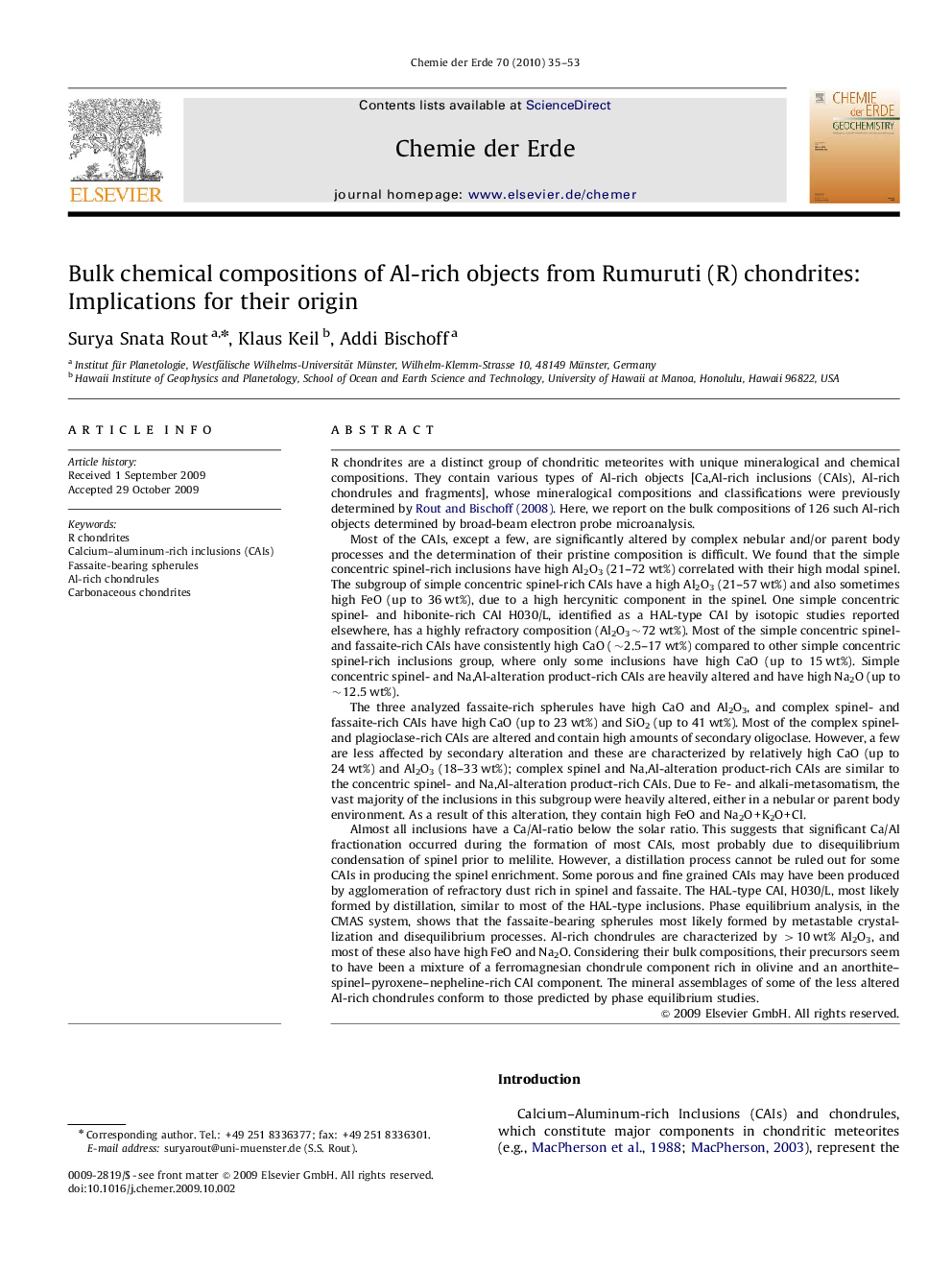| کد مقاله | کد نشریه | سال انتشار | مقاله انگلیسی | نسخه تمام متن |
|---|---|---|---|---|
| 4407122 | 1307348 | 2010 | 19 صفحه PDF | دانلود رایگان |

R chondrites are a distinct group of chondritic meteorites with unique mineralogical and chemical compositions. They contain various types of Al-rich objects [Ca,Al-rich inclusions (CAIs), Al-rich chondrules and fragments], whose mineralogical compositions and classifications were previously determined by Rout and Bischoff (2008). Here, we report on the bulk compositions of 126 such Al-rich objects determined by broad-beam electron probe microanalysis.Most of the CAIs, except a few, are significantly altered by complex nebular and/or parent body processes and the determination of their pristine composition is difficult. We found that the simple concentric spinel-rich inclusions have high Al2O3 (21–72 wt%) correlated with their high modal spinel. The subgroup of simple concentric spinel-rich CAIs have a high Al2O3 (21–57 wt%) and also sometimes high FeO (up to 36 wt%), due to a high hercynitic component in the spinel. One simple concentric spinel- and hibonite-rich CAI H030/L, identified as a HAL-type CAI by isotopic studies reported elsewhere, has a highly refractory composition (Al2O3∼72 wt%). Most of the simple concentric spinel- and fassaite-rich CAIs have consistently high CaO (∼2.5–17 wt%) compared to other simple concentric spinel-rich inclusions group, where only some inclusions have high CaO (up to 15 wt%). Simple concentric spinel- and Na,Al-alteration product-rich CAIs are heavily altered and have high Na2O (up to ∼12.5 wt%).The three analyzed fassaite-rich spherules have high CaO and Al2O3, and complex spinel- and fassaite-rich CAIs have high CaO (up to 23 wt%) and SiO2 (up to 41 wt%). Most of the complex spinel- and plagioclase-rich CAIs are altered and contain high amounts of secondary oligoclase. However, a few are less affected by secondary alteration and these are characterized by relatively high CaO (up to 24 wt%) and Al2O3 (18–33 wt%); complex spinel and Na,Al-alteration product-rich CAIs are similar to the concentric spinel- and Na,Al-alteration product-rich CAIs. Due to Fe- and alkali-metasomatism, the vast majority of the inclusions in this subgroup were heavily altered, either in a nebular or parent body environment. As a result of this alteration, they contain high FeO and Na2O+K2O+Cl.Almost all inclusions have a Ca/Al-ratio below the solar ratio. This suggests that significant Ca/Al fractionation occurred during the formation of most CAIs, most probably due to disequilibrium condensation of spinel prior to melilite. However, a distillation process cannot be ruled out for some CAIs in producing the spinel enrichment. Some porous and fine grained CAIs may have been produced by agglomeration of refractory dust rich in spinel and fassaite. The HAL-type CAI, H030/L, most likely formed by distillation, similar to most of the HAL-type inclusions. Phase equilibrium analysis, in the CMAS system, shows that the fassaite-bearing spherules most likely formed by metastable crystallization and disequilibrium processes. Al-rich chondrules are characterized by >10 wt% Al2O3, and most of these also have high FeO and Na2O. Considering their bulk compositions, their precursors seem to have been a mixture of a ferromagnesian chondrule component rich in olivine and an anorthite–spinel–pyroxene–nepheline-rich CAI component. The mineral assemblages of some of the less altered Al-rich chondrules conform to those predicted by phase equilibrium studies.
Journal: Chemie der Erde - Geochemistry - Volume 70, Issue 1, March 2010, Pages 35–53